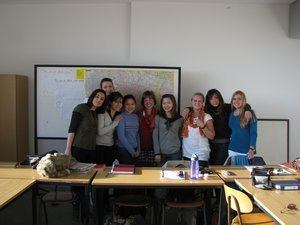Advertisement
Published: September 8th 2009

 Intensive German B1
Intensive German B1
Our last day of the course... all girls! There were also quite a few different nationalities with Italian, Indonesian, Taiwanese, Swedish, and American.Months after being here, I still haven’t put a dent into seeing the entire city! Berlin has a population of nearly 3.5 million, but aside from its population, there are so many museums, monuments, parks, etc. that one must see when in this city.
This past week, as one of my language courses came to an end, we decided to visit the DDR Museum and the memorial at Bernauer Straße (street) together for one final memory of the course. My teacher has lived in Berlin all of her life and had a lot of interesting facts to add to our tour.
We started by meeting at the S- and U-bahn station Gesundbrunnen. The Bernauer Straße memorial is only a short walking distance from the station. Just so you can understand more clearly, I should first give you an explanation of the history of the Bernauer Straße. Starting in 1961 when Berlin was divided into the East and the West, the Berlin Wall (which at that time was a low, barbed-wire fence border) was situated along this street. The actual street was part of the French sector of the West, but just on the other side of the street was

 Der Ampelmann!
Der Ampelmann!
This "ampel man" is one of the view things adapted into West Germany and kept from the former East Germany. It was first introduced in the DDR in 1961. Speaking from experience, NEVER JAYWALK!!! Both pedestrians and drivers will be angry! Germans follow all rules from what I have learned. East Berlin. The street was the scene of many daring escapes and brave escape attempts while the wall divided the city. There were apartment buildings on the side of the street located in East Germany. Bernauer Straße became quite famous for window escapes from the apartment blocks in the East. Unfortunately, by autumn of 1961, the houses were emptied, and the buildings were completely demolished later in 1963. Can you imagine having a wall built overnight, making it impossible to see your relatives, friends, and neighbors living just across the street? More than ten people died trying to cross this street to enter into the West; however, nearly 90 people successfully escaped through tunnels dug under the street and wall.
Today, signs describing some of the escapes are found along the street. There is also a remaining piece of the wall. There is now the Kapelle der Versöhnung (Chapel of Reconciliation), which is built out of clay and left behind ruins from the former, demolished Kirche St Elisabeth. This 19th-century neo-gothic church stood in the death strip between the two parts of the wall. Like its neighboring houses, the church was abandoned, and in 1985, the East German government

 Escape Tunnel
Escape Tunnel
This marks where the tunnel 57 began.ordered for it to be destructed. The chapel is a literal ghost of the church's former self.
One of the most famous escapes on the Bernauer Straße is that of Conrad Schumann, an East German soldier. On August 15, 1961, Schumann was a guard for the Berlin Wall situated at the corner of Bernauer Straße and Ruppinerstraße. While people in the West were shouting, “Komm rüber!” (Come over!), Schumann ran and jumped over the then barbed-wire fence. A photographer captured the image, and a West Berlin police car was waiting on Schumann to drive him away to a safe place.
At the site today, many other escape stories can be found as well. After spending over an hour walking through and reading the different stories, we caught the S-bahn and made our way over to the DDR Museum, which is located directly behind the Berliner Dom (Berlin Dome) on the Spree River. In this museum, one can view the products that were only available in the former East Germany. There is also an apartment scene to show the style of the interior design. If you are tired from standing, you may decide to sit in the theater-like corner

 Conrad Schumann
Conrad Schumann
Here is the photo of the soldier jumping across the Wall. This picture would later become a well-known photo of the Cold War.where a video is played, which interviews people living in the East during the 60’s and 70’s. People discuss both positive and negative aspects of living in the East.
One of my favorite displays at the museum was the Trabi (or Trabant). This was the only car that East Germans were able to purchase, that is, after saving and being on a waiting list for years. They definitely weren’t made of the quality that we are fortunate to have today!
Overall, I would say that despite the cramped space, the DDR Museum is an interesting stop to any tourist wanting to learn more about East Germany and the lifestyle of the people who lived there.
Until next time…
Advertisement
Tot: 0.06s; Tpl: 0.011s; cc: 5; qc: 44; dbt: 0.0393s; 1; m:domysql w:travelblog (10.17.0.13); sld: 1;
; mem: 1.1mb

 Intensive German B1
Intensive German B1
 Der Ampelmann!
Der Ampelmann!
 Escape Tunnel
Escape Tunnel
 Conrad Schumann
Conrad Schumann










